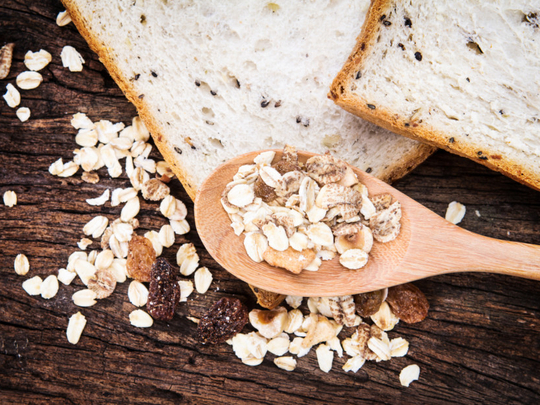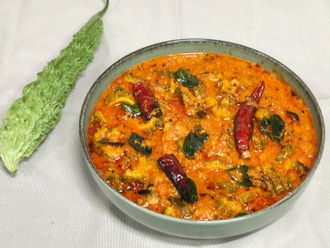
Some people go off gluten because they have gastrointestinal problems. Others because they think it will aid with weight loss. Yet others are convinced that a gluten-free diet is more healthful. By one estimate, almost 1 American in 3 reports cutting down on gluten, a mixture of proteins that is found in grains such as wheat, barley and rye. Yet scientists warn that for most people, this may be a bad idea.
For those with coeliac disease, eating the wrong foods can be life-threatening. But there’s no such danger for people with another condition — non-coeliac gluten sensitivity (NCGS) — that has recently gained traction as a reason for going gluten-free.
“Although non-coeliac gluten sensitivity appears to be a real problem, a substantial number of people are on a too-restricted diet,” says Knut Lundin, a Norwegian gastroenterologist who researches both coeliac disease and NCGS.
If it’s not a medical necessity, doctors say, going gluten-free could mean a diet that’s lacking in important nutrients, damaging to your gut flora and — ironically, for those trying to slim down — making you fat.
Although NCGS has been known in scientific circles since 1970s, researchers can’t agree on what it really is. So far, the most common way of defining the condition is saying what it isn’t: not coeliac disease, not an allergy.
Coeliac disease is an autoimmune disorder in which gluten ingestion damages the small intestine, leading to problems with nutrient absorption and sometimes to type 1 diabetes, multiple sclerosis, infertility, malnutrition, cancer and even early death. About 1 per cent of Americans have coeliac disease. It can be diagnosed by a blood test followed by a biopsy of the small intestine to look for inflammation.
Wheat allergy, on the other hand, is an immunologic reaction to wheat proteins, including gluten, that affects only about 1 Westerner in 1,000 — though it, too, may kill.
For NCGS, however, there are no tests. If a person complains of certain symptoms — abdominal pain, nausea, bloating, diarrhoea or constipation, headaches — the only way of knowing whether gluten is the problem is through a gluten challenge.
According to Umberto Volta, a professor of medicine at Italy’s University of Bologna and one of the leading researchers in NCGS, in an ideal world each person suspected of gluten sensitivity would go through a double-blind, placebo-controlled trial. After a few weeks on a gluten-free diet, the person would try different doctor-prescribed products, not knowing whether they contain gluten, and any resulting symptoms would be noted.
“Unfortunately, this procedure is time-consuming and difficult to perform routinely, so it’s still confined to the clinical setting,” Volta says. Since gluten-free and gluten-containing versions of available food products vary in taste, tests are hard to do. This can lead to a “nocebo effect”: If the patient believes he is getting gluten, he may feel worse even if his food is gluten-free. “A thorough assessment of such patients often reveals that other factors, such as small intestinal bacterial overgrowth or lactose intolerance, are responsible for their symptoms,” Volta says.
The lack of diagnostic tools and the nocebo effect make it difficult to know how many people have NCGS. Estimates vary widely, ranging from 0.5 per cent (an American study) to 6 per cent (a British study).
To add to the confusion, laboratory experiments involving NCGS differ in their outcomes. In 2011, a double-blind, placebo-controlled trial on patients with irritable bowel syndrome, whose symptoms include bloating, diarrhoea and nausea, found that they fared worse after consuming gluten. But that study allowed patients to stay on their usual diets, possibly confounding the findings. So lead author Jessica Biesiekierski, a nutritionist at the University of Leuven in Belgium, decided to try reproducing the results in a trial with tighter controls.
“This time we [provided] absolutely everything in terms of food,” she says. “But after spending over two years on the second study, we did not reproduce the results.” In fact, the symptoms appeared to be caused by a group of carbohydrates — they’re known by the acronym FODMAPs — that don’t get broken down and absorbed in the small intestine. They are present in high amounts in wheat and barley but also in milk, onions, apples and many other foods.
Yet a few studies do point to gluten as the likely reason why some people feel bad after eating wheat-based bread or cookies. In one published this year by Volta and his colleagues, 61 adults who believed gluten was behind their intestinal troubles received a placebo pill or one containing gluten daily for a week. “Gluten ingestion resulted in a significantly higher severity of symptoms than placebo,” Volta says.
Many researchers believe that some people who think they have gluten sensitivity may in fact be suffering from undiagnosed coeliac disease. “In the United States, 83 per cent of people who have coeliac disease don’t know about it. That is why absolutely no one should be going on a gluten-free diet before they have been tested for coeliac,” says Tricia Thompson, a registered dietitian who specialises in gluten-free diets.
If you do have coeliac disease, cutting down on gluten can make you feel better — good enough not to seek medical advice — yet even minimal amounts of gluten will continue damaging your small intestine, raising the risk of complications. “The problem is that the gluten-free diet as followed by most Americans is not a true gluten-free diet. They probably don’t know that breakfast cereal may have malt colouring in it; they are not as concerned about cross-contamination,” Thompson says.
A self-prescribed gluten-free diet can mess up coeliac diagnosis.
“If you have coeliac and you start a gluten-free diet, your gut will normalise and your blood results will normalise, which makes diagnosis difficult,” Lundin says.
Meanwhile, for those who don’t have coeliac or NCGS, loading up on gluten may be a good idea. “Blogs and websites are giving gluten a bad name, but both gluten and FODMAPs are beneficial for somebody with a healthy gut,” Biesiekierski says.
For one, gluten — specifically, the amino acid glutamine, which is found in gluten — may boost the immune system. A 2002 review found that glutamine supplementation lowered the risk of infections after surgery.
Second, a diet high in gluten may be good for your heart. In one Canadian study, when adults with elevated LDL cholesterol — often called “bad” cholesterol — increased their consumption of gluten, their serum triglyceride levels (which when elevated suggest cardiovascular health risk) went down by 13 per cent within two weeks.
And third, beneficial gut bacteria thrive on gluten. These are the types of bacteria that help with digestion, boost the immune system and keep us lean. A small experiment published in 2009 in the “British Journal of Nutrition” found that just one month on a gluten-free diet significantly reduced levels of good microbes in the gut and increased levels of pathogenic ones such as E. coli.
Although it is possible to compose a gluten-free diet that contains all necessary nutrients, doing so is not easy. “Gluten-free diets as typically followed in the United States tend to be low in calcium, iron, folate, B3, B12, phosphorus and zinc,” says Thompson, who 15 years ago was among the first to point out the nutritional pitfalls of going gluten-free.
Of 37 gluten-free products that Thompson analysed, 30 had smaller amounts of folate — which helps tissue grow — than their gluten-containing counterparts. In another of her studies, 61 per cent of gluten-free products had less of vitamins B1, B2 and B3, which are essential for proper function of cells. Also in short supply was iron, needed for the transport of oxygen in the blood.
One reason for these differences is that refined wheat-based products are enriched with vitamins and minerals while almost all gluten-free ones are not. Gluten-free foods also tend to be low in fibre, consumption of which lowers the risk of diabetes and heart disease. (A study in Finland showed that coeliac patients consumed only 45 per cent as much fibre as did average Finns.)
Can a gluten-free diet at least help you lose weight? More likely just the opposite, experts say. “Frequently patients risk weight gain due to higher calorific content of gluten-free products,” explains Volta.
To make gluten-free products appealing, extra fat and starches are often added, which means more calories. A recent comparison of foods in Spain showed that gluten-free breads, pastas and pastries contained, on average, twice as much fat as their traditional equivalents. This may partially explain why, as several studies have shown, people with coeliac disease often put on weight when they start their new regime.
A 2006 study found that when 67 overweight adults with coeliac disease went on a gluten-free diet for two years, 82 per cent of them gained weight. (Some of the weight gain was attributed to better absorption of nutrients because of reduced inflammation of the participants’ intestines.)
Most researchers agree that a gluten-free diet should not be self-prescribed. If you suspect you are sensitive to gluten — perhaps because indulging in bread or cookies results in an upset stomach a few hours later — don’t alter your diet before you see a doctor or a dietitian. You should get coeliac tests done first, since changed eating patterns can affect the results. If they come back negative, a gluten challenge should be the next step.
Once it’s clearly established that your symptoms are due to gluten, you may need to take it out of your diet. But proceed cautiously — and make sure you get all your vitamins and minerals.
“Eat quinoa, amaranth and millet, which are fine for people with gluten-related disorders. Look at the ingredients lists and look for products that have a whole grain listed as the first one,” Thompson recommends.
–Washington Post

















